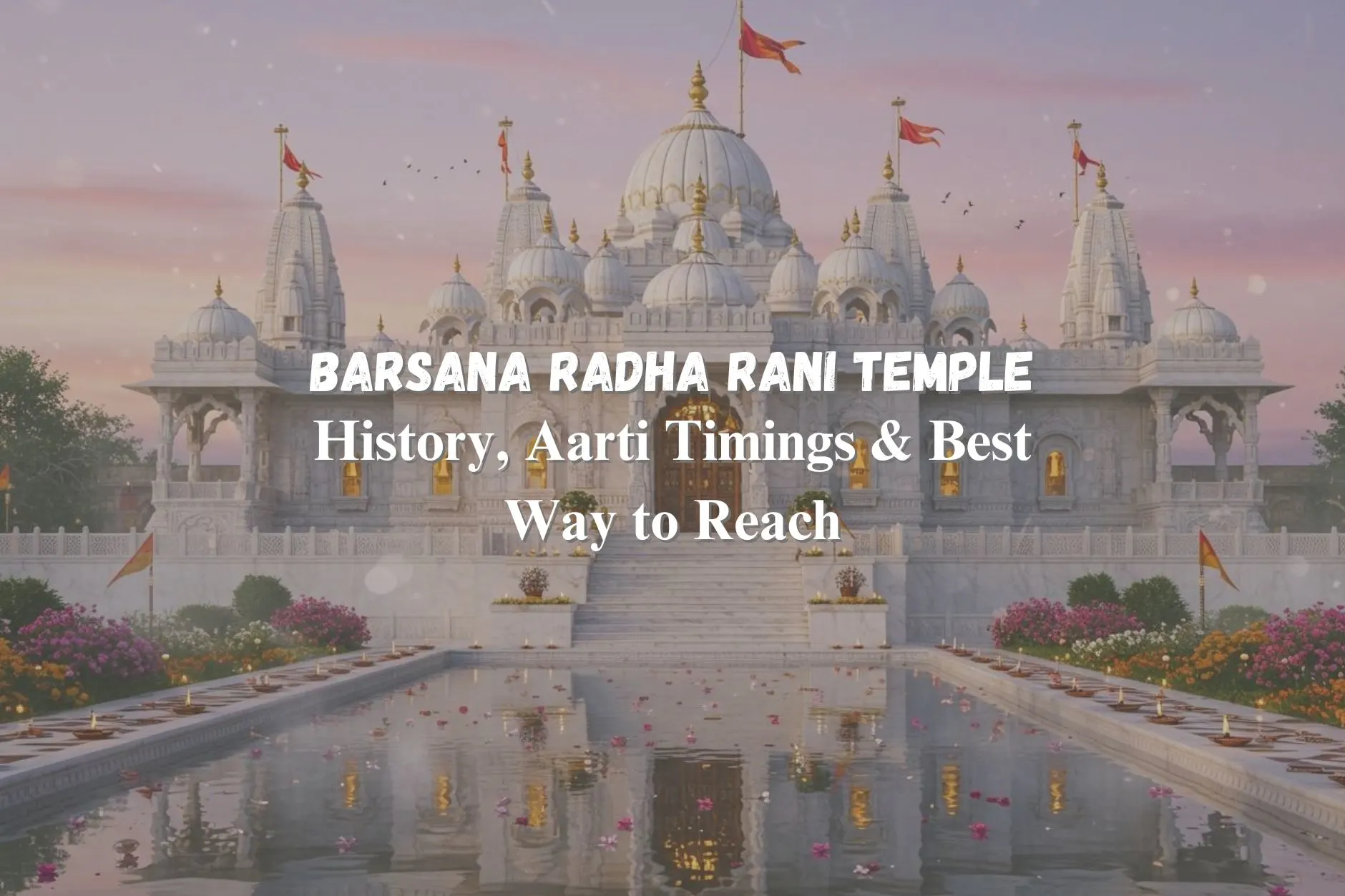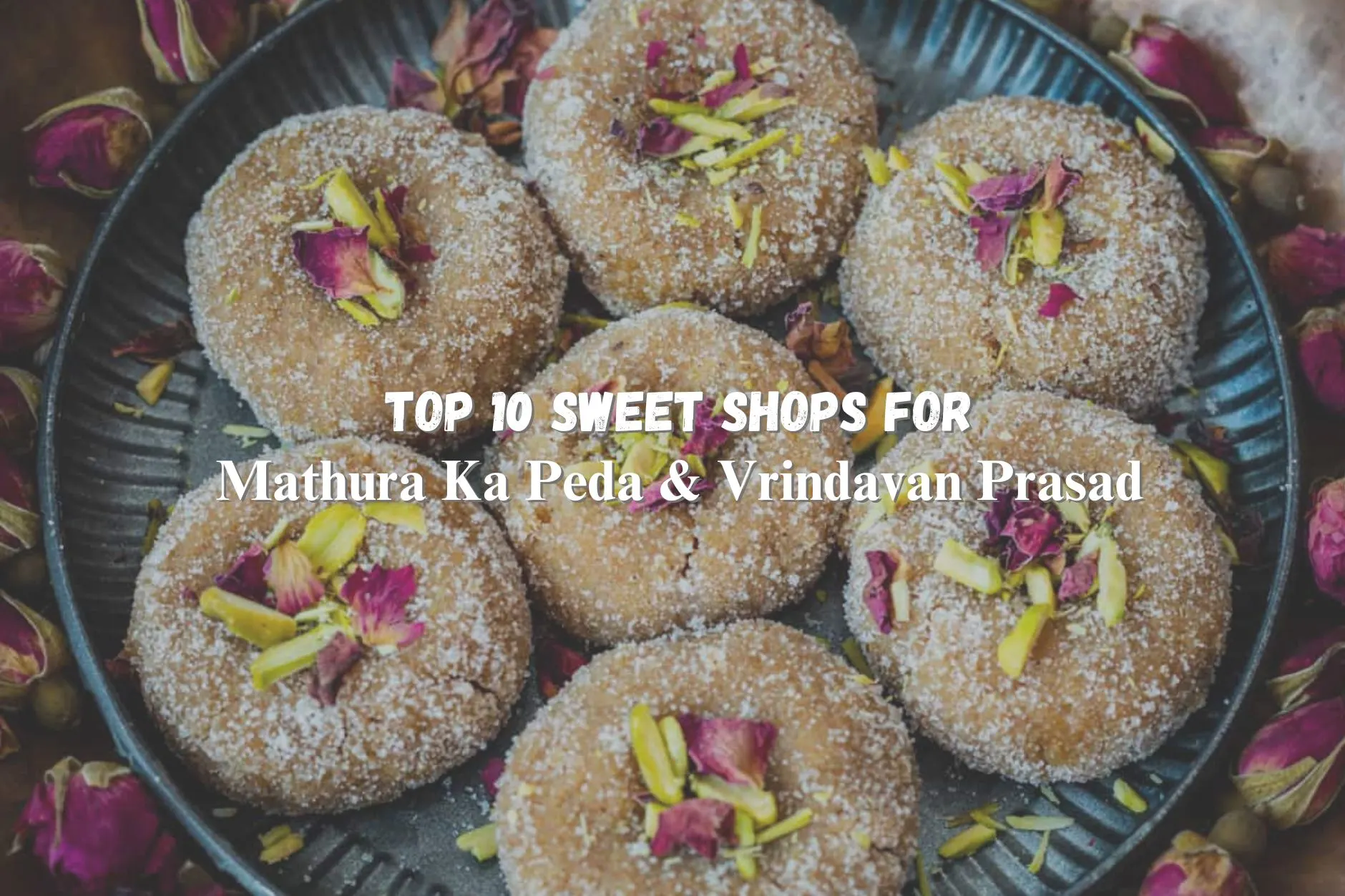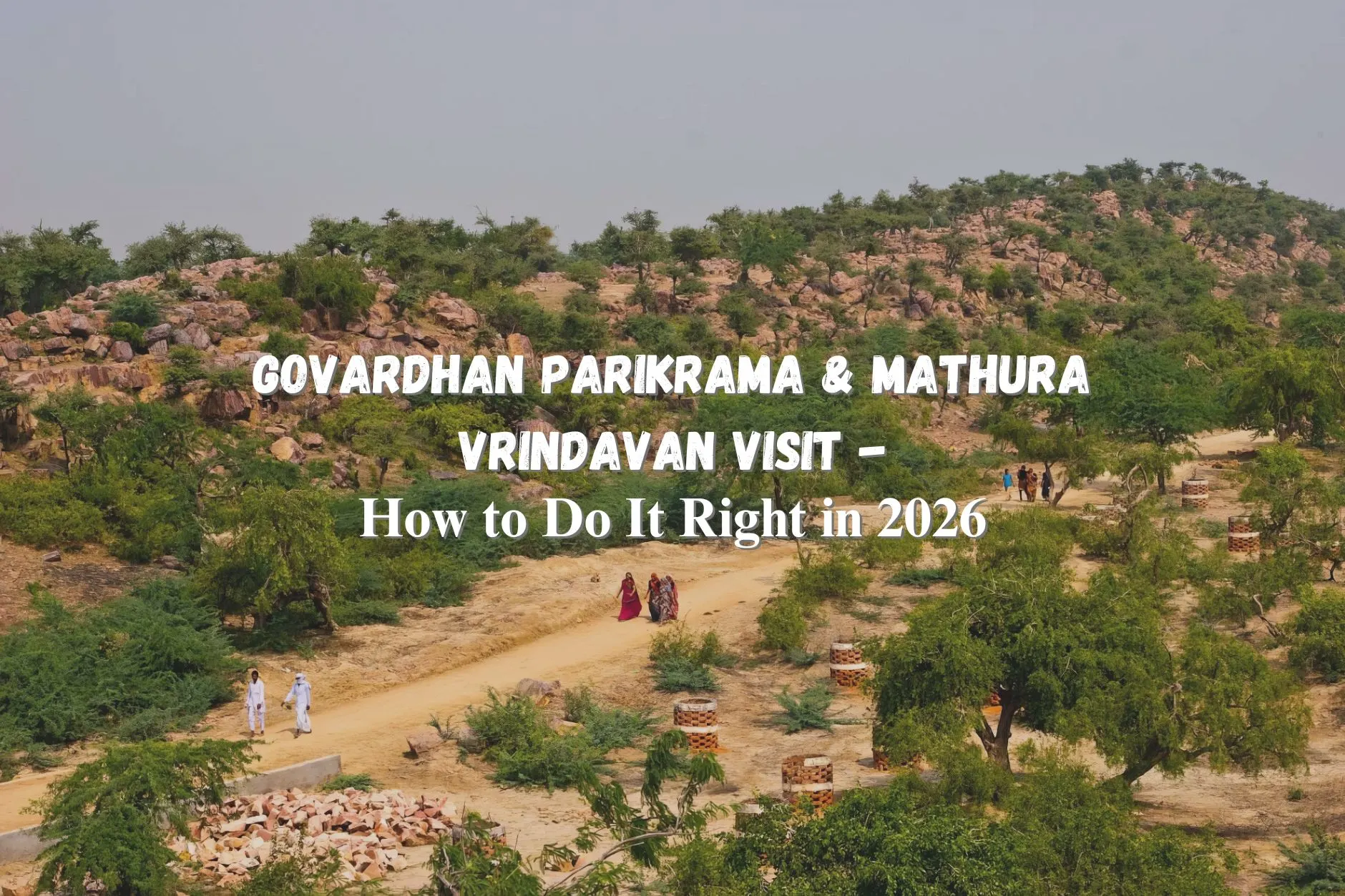Craving a divine blend of flavors with spiritual vibes?
Welcome to Mathura and Vrindavan—where every bite tells a sacred story. These twin cities are not just famous for their temples and festivals but also for a culinary tradition that reflects the rich spiritual essence of the land.
In these sacred towns, food is more than sustenance—it’s prasadam, an offering, a ritual, a celebration of life and devotion.
This Mathura food guide will walk you through must-try dishes, famous eateries, and hidden gems that will satisfy your soul as much as your taste buds.
Quick Look: Famous Dishes & Where to Try
| Delicacy | Location | Best For |
|---|---|---|
| Mathura Peda | Brijwasi Sweets, Holi Gate | Religious offerings & gifts |
| Kachori Sabzi | Radhika Misthan Bhandar, Vrindavan | Breakfast with spice |
| Lassi | Shree Radha Lassi, Mathura Chowk | Refreshing dairy drink |
| Chhappan Bhog Thali | Govinda Restaurant, ISKCON Temple | Sattvik temple meal |
| Rabri & Malpua | Brij Rasoi, Vrindavan | Dessert lovers |
1. The Legendary Mathura Peda
The Mathura peda is not just a sweet—it’s an emotion tied to devotion. Made from slow-roasted khoya (dried milk solids), pure ghee, and sugar, this brown, grainy delight carries a unique smoky aroma.
It is deeply associated with temple offerings and is considered one of the most sacred sweets in India.
The peda is often offered to Lord Krishna and then distributed to devotees as prasadam. This makes it more than just a culinary item—it becomes a spiritual experience.
Brijwasi Mithaiwala, near Holi Gate, is the most celebrated spot to taste and purchase authentic Mathura pedas. You can buy small or bulk boxes, beautifully packed, ideal as edible souvenirs for friends and family.
2. Vrindavan’s Sattvik Food Culture
Vrindavan follows a strictly sattvik (pure vegetarian) food tradition. This means no onions, garlic, or meat—just wholesome meals that reflect inner purity. Food here is treated with reverence, and recipes are handed down from temple kitchens and ancient texts.
Whether you’re a spiritual seeker or a curious traveler, the devotional approach to food in Vrindavan adds a calming, healing vibe to every meal. For a full experience, try the temple-style bhojan at Govinda Restaurant, inside the ISKCON temple.
You’ll receive a meal infused with mantras, intention, and love—served on banana leaves or steel thalis, keeping traditions alive.
3. Breakfast Bliss: Bedai & Jalebi
Mornings in Mathura are incomplete without Bedai and Jalebi. Bedai is a stuffed, spicy version of kachori, paired with a rich potato curry. Its crispiness, when dipped in tangy sabzi, gives a hearty start to your day.
Pair this savory delight with hot jalebis, spiraled deep-fried sweets soaked in saffron syrup. The combo is irresistible. The best place to try this is Radhika Sweets, near the Banke Bihari Temple. The aroma of frying kachoris fills the morning air, making it a must-visit breakfast stop, especially on festive mornings.
4. Cooling Down with Lassi
As the Braj sun blazes down, nothing refreshes better than a glass of chilled lassi. This creamy yogurt-based drink is infused with cardamom, saffron, and crushed dry fruits, served traditionally in kulhads (earthen pots) that add a rustic charm.
At Shree Radha Lassi Bhandar, on Mathura Junction Road, you’ll get lassis so thick they’re eaten with a spoon. Don’t miss their mango and rose lassi variants, especially during summer months. It’s not just a drink—it’s a cooling ritual for pilgrims and locals alike.
5. Temple Prasadam: Chhappan Bhog
On special days, temples serve a magnificent feast called Chhappan Bhog—a divine platter of 56 food items. It includes sweet, savory, tangy, and cooling dishes symbolizing abundance and gratitude.
The ISKCON Temple and Prem Mandir in Vrindavan are famous for these elaborate offerings. After your darshan (temple visit), sit for the prasadam meal that feels like a sacred ceremony in itself. Each dish is prepared with care and devotion, creating a meal that nourishes body and soul.
6. The Street Food Scene
The narrow alleys of Mathura and Vrindavan are bursting with flavors. Street vendors dish out hot, fresh, and exciting snacks that reflect local culture and seasonal specialties.
Try:
- Aloo Tikki with chutneys near Vishram Ghat
- Kulhad Chai at Chatta Bazaar
- Boondi Laddoos sold during religious parikramas (processions)
The street food here isn’t fancy or gourmet—it’s honest, flavorful, and full of soul.
7. Rabri & Malpua: Heaven in a Bowl
When it comes to desserts, nothing beats the rich, creamy rabri paired with crispy, syrupy malpuas. The contrast of textures and warm-cool sensation make this a dessert worth traveling for.
Served in terracotta bowls, the experience is both traditional and indulgent. Visit Brij Rasoi, near the Yamuna Ghats, to savor the best version of this sweet pairing. It’s a favorite among both pilgrims and dessert lovers.
8. Hidden Gems Only Locals Know
Sometimes, the most authentic experiences come from lesser-known places. Locals often swear by hidden joints where recipes are passed down through generations.
- Mohan Misthan Bhandar, Mathura – specializes in milk-based sweets
- Annapurna Bhojnalaya, Vrindavan – simple, affordable meals, perfect for long stays
- Gopal Dhaba, near ISKCON – known for quick service and budget thalis
These are the places where the real food story of Mathura and Vrindavan unfolds.
9. Evening Bhog Markets
As the sun sets, the lanes near Banke Bihari and Dwarkadhish temples come alive with food vendors. The smell of roasted makhanas, ghee-soaked sweets, and fresh snacks fills the air, attracting locals and tourists alike.
It’s the perfect time to take a food trail walk, sampling whatever catches your eye. The vibe is festive, and the food is filled with the joy of community and celebration.
10. Where Devotion Meets Dessert
Some sweets here are more than just desserts—they are religious symbols. Offered as bhog, these items carry mythological significance:
- Makhan Mishri: Lord Krishna’s favorite combo
- Tulsi Laddoo: Offered to Radha Rani
- Dry Fruit Peda: Made during Janmashtami and Radhashtami
You’ll find these near major temples and during big festivals, reinforcing how deeply food and faith are intertwined.
11. Best Food Souvenirs from Mathura
Take a bit of Braj’s flavor home with you:
- Vacuum-packed pedas
- Temple dry fruits from Govardhan
- Sweetened mathri and namkeen mixtures
Buy them at Holi Gate Market or Dauji Lane, where variety and authenticity meet.
12. Eco-Friendly Eating: Try a Thali
Many dhabas now serve eco-conscious meals in reusable steel thalis. One such place is Jai Shri Radhe Bhojnalaya, where devotion also includes a respect for nature.
It’s a simple step, but an impactful one—showing how sacredness extends to how we treat the Earth.
13. Foods to Avoid for First-Time Visitors
While the food is heavenly, it’s wise to take precautions:
- Avoid raw chutneys during summer
- Skip roadside dairy items at night
- Don’t eat heavy sweets before parikrama
Follow the locals—their habits are your safest guide.
14. Food Festivals to Watch Out For
Mathura and Vrindavan come alive with food during major festivals:
- Annakoot Mahotsav (post-Diwali): mountains of sweets offered to the deity
- Janmashtami Feasts: Krishna’s birthday midnight bhog
- Holika Bhojan: traditional foods served during Holi
These are the ultimate days for food lovers to witness sacred feasting at its finest.
15. Tips for Foodies Visiting Mathura & Vrindavan
- Always carry bottled water
- Explore food near temples—it’s fresh and blessed
- Ask for milder spice levels if you’re not used to North Indian heat
- Visit sweet shops early for the freshest offerings
Planning your meals not only enhances the experience—it becomes a culinary pilgrimage.
Final Bite: Taste That Transcends Time
The divine food culture of Mathura and Vrindavan is not just about flavor—it’s a journey through devotion, culture, and community. From the softest pedas to the spiciest kachoris, from sacred bhogs to sweet offerings—each bite tells the story of Braj.
Let this Mathura food guide be your starting point to explore a cuisine that’s as eternal as the deities worshipped here.
Hungry for Braj’s Best Bites?
🌐 Explore sacred food trails at: www.mathurataxiservice.com
🍽️ Check packages with meals included:
- Spiritual Food Trail: Mathura Vrindavan
- 2-Day Tasty Temple Tour
📞 Contact us for bookings: Contact Us
Taste devotion. Feel the culture. One bite at a time.
FAQs
1. What is the most famous sweet in Mathura?
Mathura Peda is the most iconic sweet, made from khoya and loved by locals and pilgrims alike.
2. Are there any must-try street foods in Mathura and Vrindavan?
Yes, try kachori-sabzi, jalebi, chaat, and lassi from local stalls and sweet shops.
3. Where can I find the best peda in Mathura?
Head to Brijwasi Sweets or Omkara Peda Bhandar for authentic Mathura peda.
4. Are the food options vegetarian in these cities?
Yes, almost all eateries serve pure vegetarian food due to religious customs.
5. Which restaurants are popular among tourists?
Tourists love Shankar Mithai Wala, MVT Restaurant, and Brij Bhog for local and clean meals.
6. Can I find South Indian food in Mathura or Vrindavan?
Yes, many places serve South Indian dishes, especially around temples and tourist spots.
7. Are there any food items unique to Vrindavan?
Yes, thandai, makhan mishri, and special satvik bhojan are unique offerings here.
8. Is the food spicy in this region?
Most dishes are mildly spiced but flavorful; you can ask for less spicy options if needed.
9. Are there hygienic food options for foreigners?
Yes, several clean and tourist-friendly cafes like Govinda’s cater to international visitors.
10. Can I try traditional temple food here?
Yes, many temples offer prasadam and satvik meals, especially during festivals.






Leave a Reply